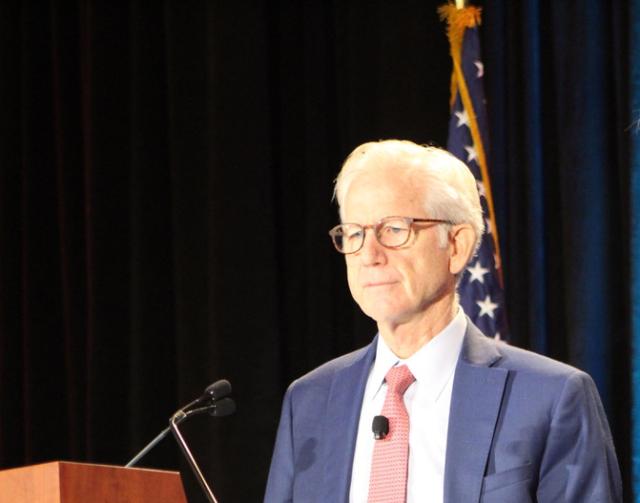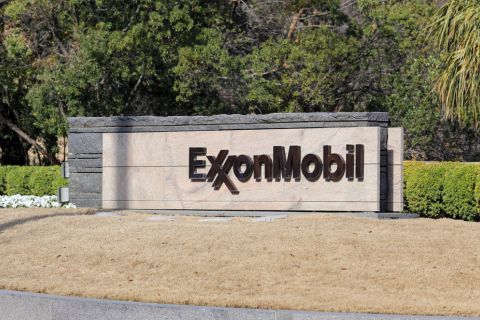
Bob Edwards, partner, NGP Energy Capital Management LLC, speaks at the recent A&D Strategies and Opportunities conference in Dallas. (Source: Emily Patsy, Hart Energy)
DALLAS—Merging E&P companies intra-portfolio and with E&Ps within other private equity firms’ portfolios is underway, according to Bob Edwards, partner at NGP Energy Capital Management LLC.
NGP merged four in-family E&Ps earlier this year and “we’ve started discussions across private-equity [firms]. There are far too many private companies,” Edwards told attendees at Hart Energy’s 18th annual A&D Strategies and Opportunities conference in Dallas.
Those inter-portfolio mergers will likely be “neighbors that don’t need two pools of G&A.”
In addition, NGP has created a portfolio-wide shared-services unit for its E&P investments “where we started getting leverage for all of our portfolio with service and supply companies and get some benefit of scale there.”
NGP is “hunkering down,” but new investment hasn’t stopped. It closed its Fund XII this past spring, raising $4.2 billion. “So we have fresh capital and are actively seeking new investments,” Edwards said.
Allocation of capital will be more biased than historically to midstream firms and minerals buyers/owners. Also counter to historical is that returns to investors will come more often from dividends derived from free cash flow and less often from the sale or other form of exit by portfolio E&Ps.
“We are now in the mode of not seeing a path in the very near term for robust exit markets, so we are setting our companies up for development and distribution,” he said. “It’s a very tough A&D market. In my career, it’s about one of the most difficult there’s been.”
It’s not really about oil and gas futures. They’re “not great, but they’re not bad. It’s not something we can blame on oil prices.”
Rather, the Lower 48 upstream business is “massively fragmented.” Investor interest is not in “40 sub-$10-billion-ish public E&P companies and a couple hundred even smaller private equity[-backed] companies.”
Resource plays favor “larger companies that can … invest $50- or $60 million in a pad before getting a [barrel] of production.”
The Street’s pushback is appropriate, he added. “Why do we feel gloom and doom? Our performance has just been miserable.”
U.S. production is growing; the problem is that “we just haven’t delivered.” The industry has gone through “technical recalibrations, if you want to call it that,” including parent/child concerns. And new ideas for increasing EURs aren’t developing as rapidly as during the past 20 years.
“The growth now is really coming from lateral-length extension and not from fundamental, new technology. So it’s plateaued and it’s a bit of a problem.”
Hence, “activity has been terrible from an A&D perspective and, as we look out to the next few quarters, it doesn’t look like it’s going to get much better.”
For now, “the public markets are dead.
“We’re not even going to have an estimate of when the public investors are going to allow us to tap the capital markets again because we are going to need multiple quarters of performance before they’ll even go back and say ‘We’ll take the risk of overcoming this type of performance.’”
Recommended Reading
Energy Capital Partners Raises $6.7B, Buys Atlantica
2024-05-29 - The New Jersey-headquartered Energy Capital Partners said its ECP V (Fund V) secured capital commitments of $4.4 billion plus an additional $2.3 billion of co-investment capital; the private equity firm also announced a $2.6 billion take-private of Atlantica Sustainable Infrastructure.
TotalEnergies Buys UK Power Plant from EIG for $575MM
2024-06-06 - TotalEnergies signed an agreement with EIG, an institutional investor in the global energy sector, for the acquisition of all the shares of West Burton Energy for an enterprise value of £450 million (US$575 million).
Exxon Appoints Maria Jelescu Dreyfus to Board
2024-05-08 - Dreyfus is CEO and founder of Ardinall Investment Management, a sustainable investment firm, and currently serves on the board of Cadiz Inc. and Canada-based pension fund CDPQ.
Utility, Clean Energy Company Allete to Go Private in $6.2B Deal
2024-05-06 - The Minnesota-based utility said on May 6 it agreed to be acquired by a partnership led by Canada Pension Plan Investment Board and Global Infrastructure Partners.
Regional Banks Take Advantage of Large Lenders’ Oil, Gas Hesitancy
2024-06-06 - Regional banks are picking up market share and rallying the U.S. upstream sector.






